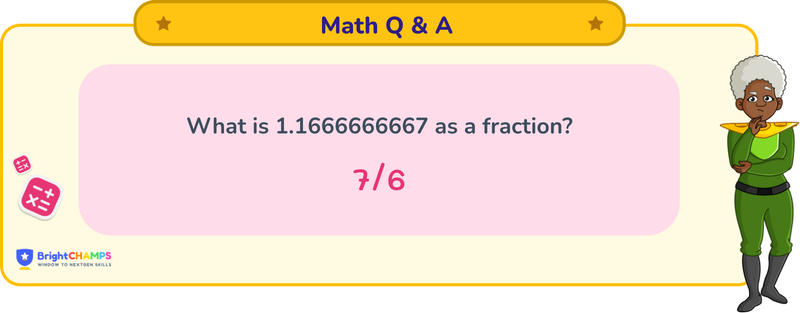
 177 Learners
177 LearnersLast updated on August 5, 2025

1.1666666667 as a Fraction

Numbers can be categorized into different types. A fraction is one such type. It is always represented in the form of p/q, where p is the numerator and q is the denominator. Fractions represent a whole and a fractional part. Decimals represent the fractional part of numbers. For example, 1/2; numbers in decimal form are expressed with a decimal point (.), For example, 1.1666666667, we are going to learn how to convert a repeating decimal to a fraction.
What is 1.1666666667 as a Fraction?
Answer
The answer for 1.1666666667 as a fraction is 7/6.
Explanation
Converting a decimal to a fraction is a task for students that can be done easily. You can follow the steps mentioned below to find the answer.
Step 1: Let's express 1.1666666667 as 1.16 with a repeating decimal notation (1.16̅). Here, 1.16̅ is the number, with 0.16̅ being the repeating part.
Step 2: Let x = 1.16̅. Multiply both sides by 100 to shift the repeating decimal: 100x = 116.6̅.
Step 3: Subtract the original equation from this new equation: 100x - x = 116.6̅ - 1.6̅, which simplifies to 99x = 115.
Step 4: Solve for x: x = 115/99, which simplifies to 7/6 after dividing both the numerator and denominator by the GCD, which is 11.
Thus, 1.1666666667 can be written as a fraction 7/6.
Important Glossaries for 1.1666666667 as a Fraction
- Fraction: A numerical quantity that is not a whole number, representing a part of a whole.
- Decimal: A number that uses the base ten and includes a decimal point to separate the whole part from the fractional part.
- Repeating Decimal: A decimal that has one or more repeating digits after the decimal point infinitely.
- Numerator: The top part of a fraction, indicating how many parts of the whole are being considered.
- Denominator: The bottom part of a fraction, showing how many parts make up a whole.





